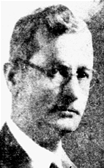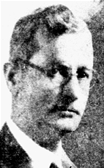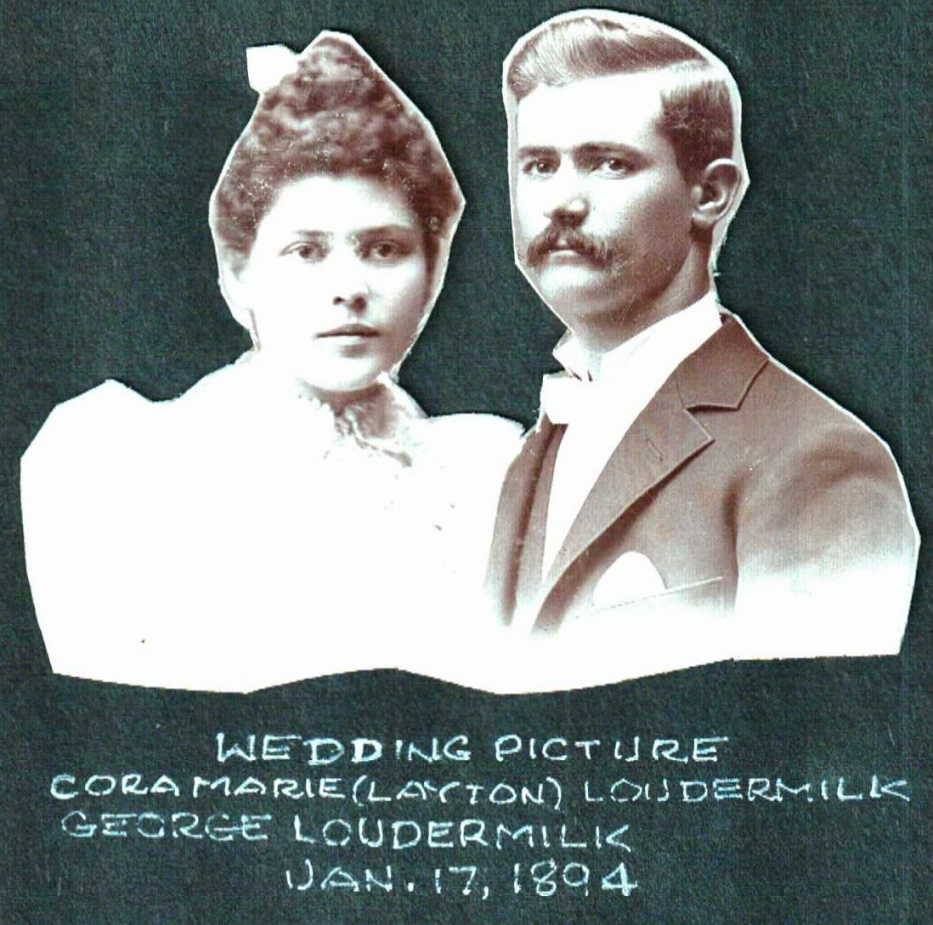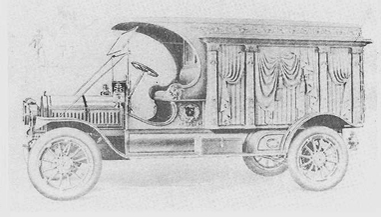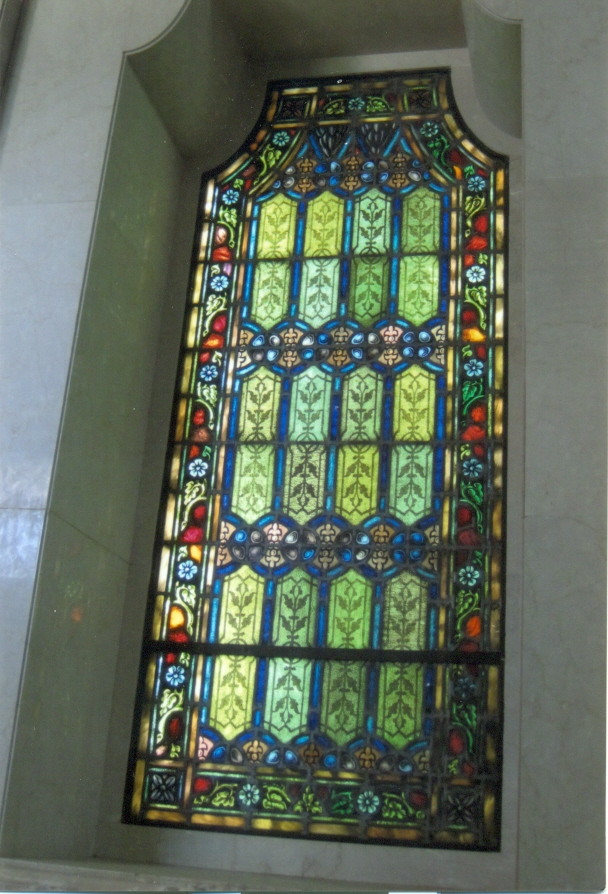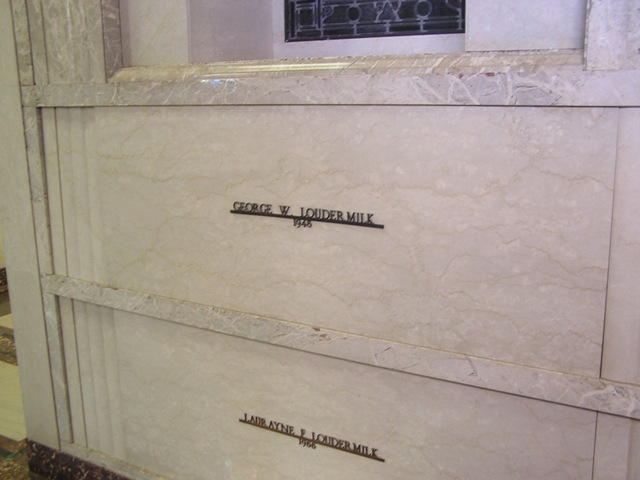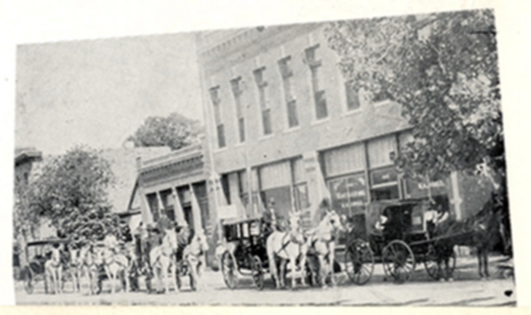George Washington Loudermilk, as a very young man, joined the staff of Patrick W. Linskie Undertaking, which had been in business since 1881 in Dallas.
1895
Geo. W. Loudermilk left Linskie to form a co-partnership with H. M. Miller, in the Miller & Ward undertaking establishment, now known as Loudermilk & Miller. Their office at 350 Elm street is always open to all calls, either personal or by telephone, and will be promptly attended to, night or day. - January 5, 1895, Dallas Daily Times Herald, p. 2, col. 4.
George W. Loudermilk only finished the 9th grade, and he was a self-taught ambitious young man. He learned everything he could about the undertaking business, and five years later, he left Miller and purchased the Linskie firm where the White Plaza Hotel now stands.
1886 Dallas city directory contains these entries:
- Loudermilk, George, a student, boards with Dr. Richard W. Allen. George was born in Georiga (Exact date unknown), but his father died when George was a young boy. He moved with his mother to Texas, but she died shortly thereafter. George was taken to Dallas where he was adopted and raised by Dr. Richard W. Allen.
- Linskie, Patrick W., Undertaker, 1135 Main, cor Harwood, r. 1133 Main.
- Allen, Richard W., physician, surgeon, office 409 Main, bt Market, Austin, r. 1125 Main. - Notice that Linskie's undertaking parlor was located near Dr. Allen's home where young Loudermilk lived, and Loudermilk probably was exposed to the undertaking business then.
1892
Loudermilk left Miller and purchased the Linskie firm and renamed it Geo. W. Loudermilk, Undertaking. Undertaker George W. Loudermilk, a forward-thinking entrepreneur of the day, began making plans with fellow businessmen to purchase land for a new cemetery that would serve the community's needs for decades to come.
1897
Mr. B. K. Coffman, the Southern agent of The James Cunningham Son and Company, of Chicago, builders of fine hearses and carriages, was in Dallas yesterday and chatted pleasantly with a Times Herald reporter. In the course of the conversation, Mr. Coffman had occasion to speak of the growing demand for the high grade variety of carriages and especially for those used in the undertaking business.
"You see," said Mr. Coffman, "the undertaking business is unlike any other business. The ethics of the business do not permit an undertaker to advertise the fact that he is burying people at reduced rates. He can't declare a sacrifice sale of coffins, either. A funeral is to those interested, an occasion of sadness, always. The duties devolving upon the undertaker call for the exercise of tact and he must go about his work in the most unobtrusive manner. This is obvious.
"It follows as a matter of course that the most effect means of increasing his business lies in his having as full and as excellent an equipment of hearses, carriages and horse furniture as money can buy.
"Our house has customers all over the country; I sell to the trade in seventeen different states, and I can truthfully say that among the equipments possessed by the largest undertaking firms in the South, there is not none that is more complete and elaborate than that of an undertaker right here in Dallas. I suppose you know whom I mean -- young Geo. W. Loudermilk, up on Elm street. "I speak of this gentleman particularly, as our house, last month, sold to him two of the finest funeral cars, popularly known as "hearses," that ever went out of the factory, together with what is known as a "top casket wagon," sometimes erroneously termed an ambulance wagon, and the horse furniture for each.
"The special features of these cars are many. One of the most melancholy things about the old style hearses was the row of stiff carved funeral urns on top. In the new cars, there is nothing of this, only a smooth, rounded top, with a polished surface like glass. On each side, and at the back, there are three handsomely hand carved columns, while between are heavy windows of French plate glass, deeply beveled. Hammer cloth seats heavily draped with fringe are another striking feature. The hearse lamps, each with four plate glass faces full silver plated, give an indescribably fine appearance to the vehicles.
"Undertaker Loudermilk has, undoubtedly, the finest equipment for doing business in the state, if not the South.
"Mr. Loudermilk, I understand, in addition to his equipment of carriages, has the finest matched team of white horses in the state, and while I live in Fort Worth, I yield the palm to a Dallas undertaker when it comes to a full complement of the things required by an up to date man in the business." Mr. Coffman left last night for the Fort. - May 23, 1897, Dallas Daily Times Herald, p. 9, col. 4-6
1910
Loudermilk purchased his first motor hearse, a Crane & Breeds Model 222, Plato, which was the really first distinct departure from the horse-drawn coach. For inclement weather the car was equipped with curtains that buttoned on the sides while the driver was further protected by a full roof over his compartment. Advertised as lower by three inches than the company's horse drawn models, the Model 222 Plato was powered by a 45-horsepower motor with four cylinders. The sides were carved wooden drapes. Source: American Funeral Cars & Ambulances Since 1900, Thomas A. McPherson, page 14.
1920
The American Funeral Director magazine reported that George W. Loudermilk sold his business to Will R. Sparkman of Jackson, Tenn., in 1920, and reportedly went to California to "seek improvement of his health."
Will R. Sparkman came to Dallas in 1920 and became Sparkman president, operating it under the name of Loudermilk-Sparkman Undertaking Company until 1933. Sparkman became very active in the state, including being a member of the state board. Sparkman began his career as a mortician when he was 17 years old at Jackson, Tennessee, and he came to Dallas in 1920 beginning business there as Loudermilk-Sparkman. At one time, he served on the Tennessee board of embalming, and he was widely known in the profession. He retired in 1933 at age 64 and moved back to Tennessee. He died in 1943 at age 74 in Bolivar, Tennessee where he had retired. Funeral and burial were there.
1924
Mr. Loudermilk returned to Dallas from California, and continued to make a fortune in real estate and other capital investment. For the building site of his first Dallas hotel, Conrad Hilton chose a prime location near the theater district and major financial business houses in downtown Dallas, on the northwest corner of Main and Harwood Streets. The site was then occupied by a two-story masonry building that was the former Loudermilk undertaking firm. The land was still owned by George W. Loudermilk, wealthy real estate investor. Loudermilk financed the new hotel. He gave Conrad Hilton a 99 year lease and loaned the money ($1.3 million) to Hilton to build his first high-rise hotel in 1925, now known as the Aristocrat on Harwood. Hilton broke ground for what would become the first hotel in his Texas highrise chain on July 25, 1924.
The impact of the Great Depression on Conrad Hilton was debilitating. He lost four hotels and saved five, one of which was the Dallas Hilton. In 1938, he relinquished the operating lease of the Dallas Hilton. George Loudermilk, still the owner, contracted with another well known hotel operator in Texas, A. C. "Jack" White, in July of 1938 to run the hotel. White changed the name of the hotel to the White Plaza, a name it would bear for the next 35 years. He also undertook improvements totaling $150,000, including improvements to the air conditioning system. The White-Plaza Hotel Company operated the hotel for 23 years, until 1961. Loudermilk resided there from the time the hotel opened until his death in 1948.
1948, June 8.
George Loudermilk died in Dallas. He was entombed in the Hillcrest Mausoleum. It is interesting to note that his occupation was listed as "captitalist" on his death certificate, which was signed by his second wife. A large, well-attended funeral was held. It was conducted by Porter Loring, longtime friend, through the Geo. Brewer Undertaking Co. in Dallas. Special police escorts helped the long procession reach Hillcrest Mausoleum.
1961
Loudermilk's estate sold the hotel in 1961 to Earlee Hotels, a Texas chain, but the hotel continued to bear the name White Plaza until 1974.
1977
In November of 1977, Opal Sebastian, real estate investor, purchased the building. She changed the name to the Plaza.
1980
In 1980, it was cited in a preservation planning report by Ellen Beasley as having potential as a national and city landmark. The Hotel is now enjoying public recognition as the Aristocrat Hotel of Dallas and it proudly displays its National Register of Historic Places, the City of Dallas Landmark and the prestigious Texas Historical Marker.
2006 - In 2006 the hotel was converted to the Dallas Hotel Indigo, franchised by InterContinental Hotels Group. The property's interior underwent a $5 million renovation that introduced hardwood floors, spa-like guest bathrooms, a business center and an upgraded fitness area. Today (2012) the hotel contains 3,000 square feet of meeting space and 169 rooms.
George Washington Loudermilk, as a very young man, joined the staff of Patrick W. Linskie Undertaking, which had been in business since 1881 in Dallas.
1895
Geo. W. Loudermilk left Linskie to form a co-partnership with H. M. Miller, in the Miller & Ward undertaking establishment, now known as Loudermilk & Miller. Their office at 350 Elm street is always open to all calls, either personal or by telephone, and will be promptly attended to, night or day. - January 5, 1895, Dallas Daily Times Herald, p. 2, col. 4.
George W. Loudermilk only finished the 9th grade, and he was a self-taught ambitious young man. He learned everything he could about the undertaking business, and five years later, he left Miller and purchased the Linskie firm where the White Plaza Hotel now stands.
1886 Dallas city directory contains these entries:
- Loudermilk, George, a student, boards with Dr. Richard W. Allen. George was born in Georiga (Exact date unknown), but his father died when George was a young boy. He moved with his mother to Texas, but she died shortly thereafter. George was taken to Dallas where he was adopted and raised by Dr. Richard W. Allen.
- Linskie, Patrick W., Undertaker, 1135 Main, cor Harwood, r. 1133 Main.
- Allen, Richard W., physician, surgeon, office 409 Main, bt Market, Austin, r. 1125 Main. - Notice that Linskie's undertaking parlor was located near Dr. Allen's home where young Loudermilk lived, and Loudermilk probably was exposed to the undertaking business then.
1892
Loudermilk left Miller and purchased the Linskie firm and renamed it Geo. W. Loudermilk, Undertaking. Undertaker George W. Loudermilk, a forward-thinking entrepreneur of the day, began making plans with fellow businessmen to purchase land for a new cemetery that would serve the community's needs for decades to come.
1897
Mr. B. K. Coffman, the Southern agent of The James Cunningham Son and Company, of Chicago, builders of fine hearses and carriages, was in Dallas yesterday and chatted pleasantly with a Times Herald reporter. In the course of the conversation, Mr. Coffman had occasion to speak of the growing demand for the high grade variety of carriages and especially for those used in the undertaking business.
"You see," said Mr. Coffman, "the undertaking business is unlike any other business. The ethics of the business do not permit an undertaker to advertise the fact that he is burying people at reduced rates. He can't declare a sacrifice sale of coffins, either. A funeral is to those interested, an occasion of sadness, always. The duties devolving upon the undertaker call for the exercise of tact and he must go about his work in the most unobtrusive manner. This is obvious.
"It follows as a matter of course that the most effect means of increasing his business lies in his having as full and as excellent an equipment of hearses, carriages and horse furniture as money can buy.
"Our house has customers all over the country; I sell to the trade in seventeen different states, and I can truthfully say that among the equipments possessed by the largest undertaking firms in the South, there is not none that is more complete and elaborate than that of an undertaker right here in Dallas. I suppose you know whom I mean -- young Geo. W. Loudermilk, up on Elm street. "I speak of this gentleman particularly, as our house, last month, sold to him two of the finest funeral cars, popularly known as "hearses," that ever went out of the factory, together with what is known as a "top casket wagon," sometimes erroneously termed an ambulance wagon, and the horse furniture for each.
"The special features of these cars are many. One of the most melancholy things about the old style hearses was the row of stiff carved funeral urns on top. In the new cars, there is nothing of this, only a smooth, rounded top, with a polished surface like glass. On each side, and at the back, there are three handsomely hand carved columns, while between are heavy windows of French plate glass, deeply beveled. Hammer cloth seats heavily draped with fringe are another striking feature. The hearse lamps, each with four plate glass faces full silver plated, give an indescribably fine appearance to the vehicles.
"Undertaker Loudermilk has, undoubtedly, the finest equipment for doing business in the state, if not the South.
"Mr. Loudermilk, I understand, in addition to his equipment of carriages, has the finest matched team of white horses in the state, and while I live in Fort Worth, I yield the palm to a Dallas undertaker when it comes to a full complement of the things required by an up to date man in the business." Mr. Coffman left last night for the Fort. - May 23, 1897, Dallas Daily Times Herald, p. 9, col. 4-6
1910
Loudermilk purchased his first motor hearse, a Crane & Breeds Model 222, Plato, which was the really first distinct departure from the horse-drawn coach. For inclement weather the car was equipped with curtains that buttoned on the sides while the driver was further protected by a full roof over his compartment. Advertised as lower by three inches than the company's horse drawn models, the Model 222 Plato was powered by a 45-horsepower motor with four cylinders. The sides were carved wooden drapes. Source: American Funeral Cars & Ambulances Since 1900, Thomas A. McPherson, page 14.
1920
The American Funeral Director magazine reported that George W. Loudermilk sold his business to Will R. Sparkman of Jackson, Tenn., in 1920, and reportedly went to California to "seek improvement of his health."
Will R. Sparkman came to Dallas in 1920 and became Sparkman president, operating it under the name of Loudermilk-Sparkman Undertaking Company until 1933. Sparkman became very active in the state, including being a member of the state board. Sparkman began his career as a mortician when he was 17 years old at Jackson, Tennessee, and he came to Dallas in 1920 beginning business there as Loudermilk-Sparkman. At one time, he served on the Tennessee board of embalming, and he was widely known in the profession. He retired in 1933 at age 64 and moved back to Tennessee. He died in 1943 at age 74 in Bolivar, Tennessee where he had retired. Funeral and burial were there.
1924
Mr. Loudermilk returned to Dallas from California, and continued to make a fortune in real estate and other capital investment. For the building site of his first Dallas hotel, Conrad Hilton chose a prime location near the theater district and major financial business houses in downtown Dallas, on the northwest corner of Main and Harwood Streets. The site was then occupied by a two-story masonry building that was the former Loudermilk undertaking firm. The land was still owned by George W. Loudermilk, wealthy real estate investor. Loudermilk financed the new hotel. He gave Conrad Hilton a 99 year lease and loaned the money ($1.3 million) to Hilton to build his first high-rise hotel in 1925, now known as the Aristocrat on Harwood. Hilton broke ground for what would become the first hotel in his Texas highrise chain on July 25, 1924.
The impact of the Great Depression on Conrad Hilton was debilitating. He lost four hotels and saved five, one of which was the Dallas Hilton. In 1938, he relinquished the operating lease of the Dallas Hilton. George Loudermilk, still the owner, contracted with another well known hotel operator in Texas, A. C. "Jack" White, in July of 1938 to run the hotel. White changed the name of the hotel to the White Plaza, a name it would bear for the next 35 years. He also undertook improvements totaling $150,000, including improvements to the air conditioning system. The White-Plaza Hotel Company operated the hotel for 23 years, until 1961. Loudermilk resided there from the time the hotel opened until his death in 1948.
1948, June 8.
George Loudermilk died in Dallas. He was entombed in the Hillcrest Mausoleum. It is interesting to note that his occupation was listed as "captitalist" on his death certificate, which was signed by his second wife. A large, well-attended funeral was held. It was conducted by Porter Loring, longtime friend, through the Geo. Brewer Undertaking Co. in Dallas. Special police escorts helped the long procession reach Hillcrest Mausoleum.
1961
Loudermilk's estate sold the hotel in 1961 to Earlee Hotels, a Texas chain, but the hotel continued to bear the name White Plaza until 1974.
1977
In November of 1977, Opal Sebastian, real estate investor, purchased the building. She changed the name to the Plaza.
1980
In 1980, it was cited in a preservation planning report by Ellen Beasley as having potential as a national and city landmark. The Hotel is now enjoying public recognition as the Aristocrat Hotel of Dallas and it proudly displays its National Register of Historic Places, the City of Dallas Landmark and the prestigious Texas Historical Marker.
2006 - In 2006 the hotel was converted to the Dallas Hotel Indigo, franchised by InterContinental Hotels Group. The property's interior underwent a $5 million renovation that introduced hardwood floors, spa-like guest bathrooms, a business center and an upgraded fitness area. Today (2012) the hotel contains 3,000 square feet of meeting space and 169 rooms.
